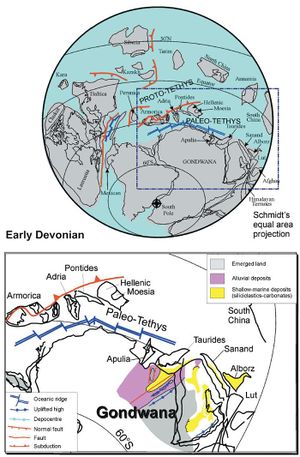Phanerozoic Tethys region
| Petroleum systems of the Tethyan region | |
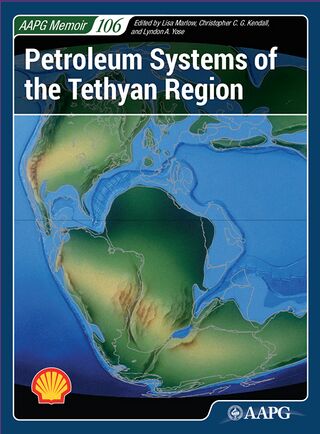
| |
| Series | AAPG Memoir |
|---|---|
| Chapter | The evolution of the Tethys region throughout the Phanerozoic: A brief tectonic reconstruction |
| Author | Fabrizio Berra, Lucia Angiolini |
| Link | Web page |
| Store | AAPG Store |
The Tethyan region is a major petroleum province. The paleogeographic position and tectonic history is a major control on sedimentation across the region, and this has influenced the sequestration of hydrocarbons in the region. The North African-Arabian plate evolved along the Tethyan margins (Proto-Tethys, Paleo-Tethys, Neo-Tethys) from Pre-Cambrian to Recent.
Paleogeographic reconstructions
Paleogeographic maps have been reconstructed for selected time intervals: Cambrian, Late Ordovician, Early Devonian, Early Permian, Permian-Triassic boundary, Norian, Callovian, Aptian, Cretaceous-Cenozoic boundary, and Late Eocene. For each time interval both the general picture of the major plate tectonic configuration and a detail of the paleogeography and paleoenvironment of North Africa to the Middle East are presented. On these maps, the major paleoenvironmental settings (from continental to shallow marine and deep ocean) are shown for the area stretching from North Africa to Afghanistan in all the selected time slices. Besides the major tectonic events, the global climate evolution and their interplay are discussed, which in some cases led to significant biotic turnovers or even to mass extinctions (e.g., Late Ordovician, Permian-Triassic boundary, Cretaceous-Cenozoic boundary). Paleogeographic maps have been compiled from literature, selecting those based on sound paleomagnetic/paleobiogeographic data. Each map is accompanied by the description of the major tectonic events that characterized the considered time interval. When contrasting paleogeographic reconstructions were available, their differences have been discussed. In general, major differences concern the interpretation of the setting and positioning of the microplates and terranes between the major continental plates.
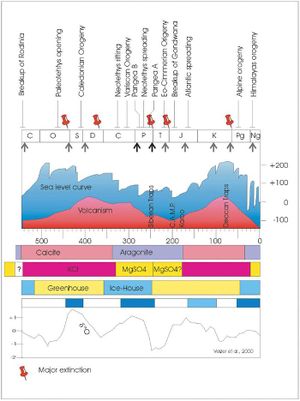
The paleogeography of the Earth during the Phanerozoic reflects the breakup of Rodinia and the formation of Pangea and its later breakup. Sedimentation was affected by the latitudinal position of the continents, the global climate conditions, and the seawater chemistry at the largest scale, and at the basin scale by the gradual changes in the local tectonic environment that accompanied the formation and destruction of the Tethyan oceans. Each global map is coupled with a more detailed map of North Africa and the Middle East. On these maps, the major depositional settings (emerged land, continental, shallow marine, and deep marine environments) are shown. These maps are a simplified view of the Western Tethys region, whereas the detailed facies distribution of the major domains is described in the chapters that follow in this book. The time-position of these paleogeographic maps is framed by the Phanerozoic history, so each map is viewed in the context of the evolution of the sea-water chemistry (aragonite vs. calcite sea, KCl vs. MgO4 evaporites), the global sea-level curve, the major volcanic events, the global climate, the major geodynamic events, and the age of the five major extinctions of the Phanerozoic (Figure 1). The interplay between these changing parameters is important as it controls and explains the distribution of climate belts (and thus the distribution of the climate-sensitive depositional environments), the depth and area of the submerged shelves, and the biogenic contribution to sediment production.
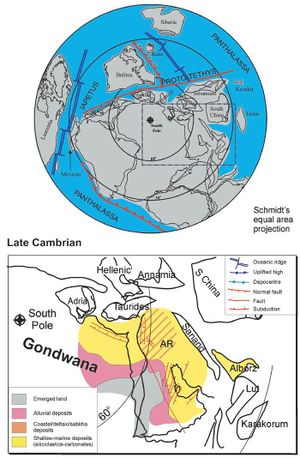
Cambrian (late Cambrian, about 500 Ma)
During Cambrian time (Figure 2) most of the continents were gathered in the southern hemisphere.[1] [3] Gondwana stretched from the equator (Australia) to the South Pole (North Africa). Tectonic movement was active mainly as a consequence of the relative rotation of the different cratons that built Gondwana.[4] Extensional tectonics that controlled the deposition of major evaporitic successions in the Arabic peninsula (Hormuz Salt Basin) and surroundings (e.g., Punjab Salt Basin) close to the Precambrian–Cambrian boundary (see dashed faults in Figure 2) came to an end, and no important tectonic activity is observed in the late Cambrian (500 Ma). Laurentia lay astride the equator in both hemispheres and was separated from Gondwana by the Iapetus Ocean. Avalonia, Armorica, Perunica, Baltica (180° geographically inverted), North and South China, and all the Cimmerian blocks fringed peripheral Gondwana at moderate to high southern latitudes. Torsvik and Cocks[3] show that South China was located close to the Equator. According to von Raumer and Stampfli,[5]d the Proto-Tethys ocean, which separated North China (to the north) from the other blocks along the peripheral Gondwana, was subducting toward the south and backarc extension, which is suggested by oceanic Cambrian seaways between the peripheral Gondwanan blocks. Torsvik and Cocks[3] recognized that their concept of the Ran Ocean used for the Cambrian-Ordovician ocean existing between Baltica and Gondwana is comparable to that of the Proto-Tethys (sensu Stampfli and Borel[2]), and herein we prefer to use the latter term. Siberia was positioned at low latitudes and was separated from Laurentia and Baltica by oceanic crust. Avalonia rifted off Gondwana in the Early Ordovician with the opening of the Rheic Ocean,[6] although some authors suggest even older ages for its opening.[3]
The scanty fossil record makes reconstruction of Cambrian paleobiogeography difficult. This fauna mostly comprises pelagic trilobites and articulated brachiopods.[1] Cocks and Torsvik[1] recognized Laurentia, Siberia, and peri-Gondwana as distinct faunal provinces. Few data are available on climate, which based on the general character of the sedimentary section was probably temperate warm to temperate cool, but arid at low latitudes. No ice seems to have been present at the poles.
Along North Africa and North Arabia, clastic continental deposits fringed a shallow water platform comprising both shales and mixed siliciclastic and carbonate facies.[7] [8]
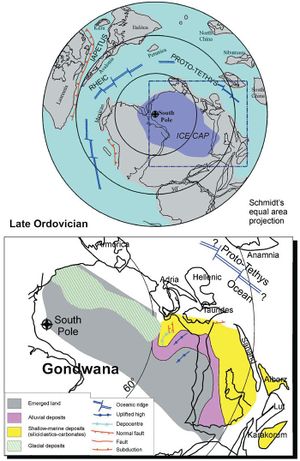
Late Ordovician (about 440 Ma)
Late Ordovician paleogeography (Figure 3) is represented by Cocks and Torsvick,[1] Robardet,[9] and Ruban et al.,[10] and shows that most continental blocks/terranes were located in the southern hemisphere except for Siberia and Tarim, which were entirely within the northern hemisphere. South China lay across the equator. The major oceans were not too large to prevent biotic exchange; thus the biota is quite cosmopolitan.
The collision of Avalonia and Baltica occurred during Late Ordovician time, as documented by paleomagnetic, tectonic, isotope, and faunal data.[1] [9] Baltica, after the accretion of Avalonia, was positioned at intermediate latitudes NW of the Northern Gondwana margin and could have deflected the South Equatorial current southward. The Iapetus Oceanic lithosphere was subducting beneath the Laurentian active margin and its width was decreasing. The Rheic Ocean was several thousands of km wide with Perunica in the northern part, having probably detached from NW Gondwana in mid-Ordovician time. According to von Raumer and Stampfli,[5] the Rheic Ocean was subducting beneath the Peri-Gondwanan blocks placed along the northern margin of Gondwana. The Panthalassic Ocean was very large and mostly covered the northern hemisphere. Cocks and Torsvik[1] suggest this ocean was comparable in size to today’s Pacific. Peri-Gondwanan blocks were located along the Gondwanan margin at high to intermediate southern latitudes. However, some faunal data (e.g., Villas et al.[11]) suggest lower latitudes, as well as the existence of peripheral blocks detaching from North Gondwana. The position and the architecture of the Armorica composite plate is still discussed (e.g., Robardet[9]). Nysæther et al.[6] suggested that by the Late Ordovician, it is possible that part of Armorica had rifted off the NW Gondwanan margin; however, Robardet[9] casted doubts on the reliability of the paleomagnetic data on which the evolution of the Armorica was based and proposed a different scenario in which the southern European blocks remained attached to the northern Gondwanan margin from Ordovician to Devonian[9] (Figure 9).
Global climate deteriorated at the end of Ordovician time, resulting in the Hirnantian glacial episode. The glaciation is documented by sedimentary evidence and isotopic data[12] and lasted about 0.5–1 million years. Peri-Gondwanan and Gondwanan glacial deposits occur in North Africa (where a N-S high was present in Egypt[13]), South America, Arabia, and South Africa, and periglacial features are known also from Armorica and Avalonia. Several interpretations have been offered on the distribution of the ice caps during the Hirnantian glaciation (a single large ice cap vs. a number of smaller ice caps), as summarized in Veevers.[4] This glaciation followed a period of climatic amelioration along the Northern Gondwana margin, evidenced by deposition of temperate bioclastic limestones and pelmatozoan-bryozoan mud-mounds, which overlie a very thick terrigenous succession of Early-Middle Ordovician age. The change from pre-Hirnantian “greenhouse” climates to Hirnantian “icehouse” conditions was rapid and was not preceded by any climatic fluctuations, which might have helped acclimatize the biota to the climate change.[12] If the pre-Hirnantian benthos was widespread in epicontinental seas and inland basins, the Hirnantian shelly fauna (e.g., Sutcliffe et al.;[14] Jin and Copper[15]) was mostly restricted to the continental margins, due to the sea-level drop caused by the glaciations in the latest Ordovician. The Hirnantian glaciation seems to have occurred during times of very high levels of the greenhouse gas CO2 (14–18 times the present atmospheric value). Brenchley et al.[12] considered that the onset of glaciation was the result of an early Hirnantian increment in burial rates of organic carbon acting as a major sink for the atmospheric CO2. However, according to Villas et al.,[11] the accumulation of great volumes of carbonates in the pre-Hirnantian late Ordovician served as the sink of the atmospheric CO2. At the end of the Hirnantian, the ice cap melting caused a rapid, eustatic sea-level rise and the development of low-oxygen conditions on the shelves.[16] [17] The end of the glaciation was followed by the deposition of organic-rich shales (Lower Silurian “hot shales”) which represent the most important source rocks in North Africa and one of the major in the Arabian peninsula.[18]
A very important event at the end of the Ordovician was the first of the Big Five Mass Extinctions[19] of the Phanerozoic, with disappearance of 85% of species, 61% of genera, and 12–24% of families.[20] The close correlation between the Ordovician extinction and the glaciation suggests climatic change as the proximate cause. However, the extinction was probably a complex event.[21] A sea-level fall and rise, changes in oceanic structure,[22] nutrient fluxes,[21] and development of anoxia[23] [24] were all ultimately related to climatic change and may have contributed to the crisis.[25]
Early Devonian (about 400Ma)
During Early Devonian time Gondwana was centered on the Southern Pole, with northern Africa and Antarctica located toward the equator (Figure 4). The continental plates that would form future Laurasia were located immediately to the south of the equator, so that most of the continental masses were in the southern hemisphere. The Iapetus Ocean had been closed by the collision between North America and Baltica, giving rise to the Caledonian orogeny. The Avalonia Ocean between southern England and Scotland was still present, and other minor oceanic seaways separated different blocks. These blocks would later form the components of Europe, assembled during the Carboniferous Variscan orogeny, with the closure of the Rheic Ocean. The width of the Rheic Ocean is still questioned, but the paleobiogeographic distribution of different groups of fossil organisms between Laurasia and Gondwana suggests that this ocean was relatively narrow during Early Devonian.[26] The Paleo-Tethys Ocean was opening along northern Gondwana, generating a fringe of microplates (e.g., Armorica, Adria, Pontides, Hellenic, and Moesia terranes). We follow the interpretation of Torsvik and Cocks,[27] who considered Adria and Apulia as separate microplates split apart by the opening of Paleo-Tethys. The width of the Paleo-Tethys Ocean at this time is still a matter of discussion. According to Robardet et al.,[28] the detachment of Armorica from Gondwana is not older than Late Devonian, and Robardet[9] considers a fiction even the concept of an Armorica microplate. Other reconstructions[2] [27] [5] suggest that the opening of the Paleo-Tethys occurred before Early Devonian, and this is more certain for the eastward extension of this ocean.[29] Besides the strongly debated concepts of Armorica (e.g., Cocks and Torsvik,[1] Nysæther et al.,[6] Robardet,[9] Torsvik and Cocks[3]), also the relative position of the microplates detached from Gondwana with the opening of the Paleo-Tethys differs in several reconstructions: Stampfli and Borel[2] and von Raumer and Stampfli[5] identify a major continental block (Hun superterrane), whereas Torsvik and Cocks[27] suggest the presence of different independent microplates. In fact, the separation of these various microplates may have been diachronous.
Most of the Asian terranes, mainly located immediately north of the equator, were still separated by seaways before their collision with and incorporation into Pangea. The position and vergence of subduction among these blocks is not clear, and different models have been proposed (e.g., Stampfli and Borel,[2] Torsvik and Cocks,[27] Ruban et al.,[10] von Raumer and Stampfli[5]).
During Early Devonian time, a global sea-level fall was responsible for the reduction of the neritic belts. The occurrence of a wide depositional hiatus close to the Early Devonian in most of the Middle East is ascribed to this sea-level low-stand, probably enhanced by a tectonic uplift.[10]. The middle latitude position of North Africa and part of Arabia favored the development of alluvial deposits. Tectonic activity was weak and limited volcanic flows are documented[30] mainly in Sudan and in the southern area of the Eastern Desert of Egypt.[13]
See also
References
- ↑ 1.0 1.1 1.2 1.3 1.4 1.5 1.6 1.7 1.8 Cocks, L. M. R., and Torsvik, T. K., 2002, Earth geography from 500 to 400 million years ago: A faunal and palaeomagnetic review: Journal of the Geological Society, v. 159, p. 631–644.
- ↑ 2.0 2.1 2.2 2.3 2.4 Stampfli, G. M., and Borel, G. D., 2002, A plate tectonic model for the Paleozoic and Mesozoic constrained by dynamic plate boundaries and restored synthetic oceanic isochrons: Earth and Planetary Science Letters, v. 196, p. 17–33.
- ↑ 3.0 3.1 3.2 3.3 3.4 Torsvik, T. H., and Cocks, L. R. M., 2009, The Lower Palaeozoic palaeogeographical evolution of the northeastern and eastern peri-Gondwanan margin from Turkey to New Zealand: GSL Special Publications, v. 325, p. 3–21.
- ↑ 4.0 4.1 Veevers, J. J., 2004, Gondwanaland from 650-500 Ma assembly through 320 Ma merger in Pangea to 185-100 Ma breakup: Supercontinental tectonics via stratigraphy and radiometric dating: Earth-Science Reviews, v. 68, p. 1–132.
- ↑ 5.0 5.1 5.2 5.3 5.4 von Raumer, J. F., and Stampfli, G. M., 2008, The birth of the Rheic Ocean - Early Palaeozoic subsidence patterns and subsequent tectonic plate scenarios: Tectonophysics, v. 461, p. 9–20.
- ↑ 6.0 6.1 6.2 Nysæther, E., Torvik, T. H., Feist, R., Walderhaug, H. J., and Eide, E.A., 2002, Ordovician palaeogeography with new palaeomagnetic data from the Montagne Noire (Southern France): Earth and Planetary Science Letters, v. 203, p. 329–341.
- ↑ Guiraud, R., and Bosworth, W., 1999, Phanerozoic geodynamic evolution of northeastern Africa and the northwestern Arabian platform: Tectonophysics, v. 315, p. 73–108.
- ↑ Konert, G., Abdulkader, M. A., Al-Hajri, A. A., and Droste, H. J., 2001, Paleozoic stratigraphy and hydrocarbon habitat of the Arabian Plate: GeoArabia, v. 6, p. 407–442.
- ↑ 9.0 9.1 9.2 9.3 9.4 9.5 9.6 Robardet, M., 2003, The Armorica “microplate": Fact or fiction? Critical review of the concept and contradictory palaeobiogeographical data: Palaeoeography, Palaeoclimatology, Palaeoecology, v. 195, p. 125–148.
- ↑ 10.0 10.1 10.2 Ruban, D. A., Al-Husseini, M. I., and Yumiko, I., 2007, Review of Middle East Palaeozoic plate tectonics: GeoArabia, v. 12, no. 3, p. 35–56.
- ↑ 11.0 11.1 Villas, E., Hammann, W., and Harper, D. A. T., 2002, Foliomena fauna (Brachiopoda) from the Upper Ordovician of Sardinia: Palaeontology, v. 45, p. 267–295.
- ↑ 12.0 12.1 12.2 Brenchley, P. J., Marshall, J. D., Carden, G. A. C., et al., 1994. Bathymetric and isotopic evidence for a short-lived Ordovician glaciation in a greenhouse period: Geology, v. 22, p. 295–298.
- ↑ 13.0 13.1 Schandelmeier, H. and Reynolds, P. O., eds., 1997, Palaeogeographic-palaeotectonic atlas of north-eastern Africa, Arabia, and adjacent areas: Balkema, Rotterdam, 160 p. 17 pls.
- ↑ Schandelmeier, H. and Reynolds, P. O., eds., 1997, Palaeogeographic-palaeotectonic atlas of north-eastern Africa, Arabia, and adjacent areas: Balkema, Rotterdam, 160 p. 17 pls.
- ↑ Jin, J., and Copper P., 2008, Response of brachiopod communities to environmental change during the Late Ordovian mass extinction interval, Anticosti Island, eastern Canada: Fossils and Strata, v. 54, p. 41–52.
- ↑ Rong, J.-Y., and Harper, D. A. T., 1988, A global synthesis of the latest Ordovician Hirnantian brachiopod faunas: Transactions of the Royal Society of Edinburgh Earth v. 79, p. 383–402.
- ↑ Owen, A. W., and Robertson, D. B. R., 1995, Ecological changes during the end-Ordovician extinction: Modern Geology, v. 20, p. 21–39.
- ↑ Luning, S., Craig, J., Loydell, D. K., Storch, P. B., and Fitches B., 2000, Lower Silurian ‘hot shales’ in North Africa and Arabia: Regional distribution and depositional model: Earth Science Review, v. 49, p. 121–200.
- ↑ Raup, D. M., and Sepkoski, J. J., 1982, Mass extinctions in the marine fossil record: Science, v. 215, p. 1501–1503.
- ↑ Sepkoski, J. J., 1997, Biodiversity: Past, present, and future: Journal of Paleontology, v. 71, p. 533–539.
- ↑ 21.0 21.1 Brenchley, P. J., Carden, G. A. F., and Marshall, J. D., 1995, Environmental changes associated with the “first strike” of the late Ordovician mass extinction: Modern Geology, v. 20, p. 69–82.
- ↑ Wilde, P., and Berry, W. B. N., 1984, Destabilization of the oceanic density structure and its significance to marine ‘extinction’ events: Palaeogeography, Palaeoclimatology, Palaeoecology, v. 48, p. 143–162.
- ↑ Fortey, R. A., 1989, There are extinctions and extinctions: Examples from the lower Palaeozoic. Philosophical Transactions of the Royal Society of London. Series B, v. 352, p.327–355.
- ↑ Briggs, D. E. G., Evershed, R. P., and Stankiewicz, B. A., 1998, The molecular preservation of fossil arthropod cuticles: Ancient Biomolecules, v. 2, p. 135–146.
- ↑ Brenchley, P. J., Marshall, J. D., and Underwood, C. J., 2001, Do all mass extinctions represent an ecological crisis? Evidence from the late Ordovician: Geological Journal, v. 36, p. 329–340.
- ↑ Wehrmann, A. et al., 2010, Devonian shallow-water sequences from the North Gondwana coastal margin (central and eastern Taurides, Turkey): Sedimentology, facies and global events: Gondwana Research, v. 17, p. 546–560.
- ↑ 27.0 27.1 27.2 27.3 Torsvik, T. H., and Cocks, L. R. M., 2004, Earth geography from 400 to 250 Ma: A palaeomagnetic, faunal and facies review: Journal of the GSL v. 161, p. 555–572.
- ↑ Robardet, M., Paris, F., and Racheboeuf, P. R., 1990, Palaeogeographic evolution of southwestern Europe during Early Palaeozoic times, in W. S. McKerrow and C. R. Scotese, eds., Palaeozoic palaeogeography and biogeography: GSL Memoirs 12, p. 411–419.
- ↑ Metcalfe, I., 2002, Tectonic history of the SE Asian-Australian region: Advances in Geoecology, v. 34, p. 29–48.
- ↑ Metcalfe, I., 2002, Tectonic history of the SE Asian-Australian region: Advances in Geoecology, v. 34, p. 29–48.
